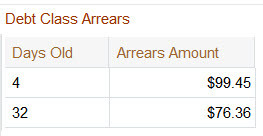Arrears
The system keeps track of the age of each customer's debt to the day. For example, if a customer hasn't paid their last two bills, the customer's aged debt might look as follows:
- $124.50: 22 days old
- $213.41: 51 days old
Please be aware that it is the current balance (i.e., what the customer thinks they owe) that is aged. Also keep in mind that the moment an FT is frozen, it impacts a customer's current balance.
The system represents aged debt in a variety of ways of the various transactions in the system. On the Current Customer Zone and the Financial Information Zone arrears are shown in a colorful bar (where each color corresponds to different aged buckets):

Whereas on Service Agreement - Main, aged debt is shown in a grid:

The grid method is used on many pages throughout the system. The following rows may appear in the grid:
- A row labeled New Charge highlights all debt that hasn't started aging yet. For example, if you've created a late payment charge and it hasn't appeared on one of the customer's bills, it will be classified as a New charge until the next bill is completed for the customer (unless a user overrides the late payment charge's arrears date by drilling into the financial transaction).
- A row with a label containing n Future (where n is the number of days) appears if there is "future debt". Future debt is very rare and can only exist if a debit financial transaction has a future arrears date. Financial transactions can receive a future arrears date if a bill is completed with a future date or if a user overrides a financial transaction's arrears date with a future date).
- A row that contains a number (and nothing else) represents debt that has started aging. The number is the age of the respective debt. In the above example, the customer has 1 day old debt, and debt that is more than 150 days old. Notice that the 150 day old debt is prefixed with a +. This means that the related debt is more than 150 days old. This age limit is controlled by a field on Installation Options - CC called "Oldest Bucket Age". This field limits the number of days the system will age debt. For example, if you set this field to 150, the system will never age an FT more than 150 days (and all debt that's older than 150 days will be classified as 150 day old debt). Also note, the aged debt bar that appears on Current Customer Zone only ages debt a maximum of 60 days.
- A row with a label of Disputed appears if the account is an open-item customer and this customer has disputed financial transactions.
Refer to Financial Transactions And Aged Debt for more information.
